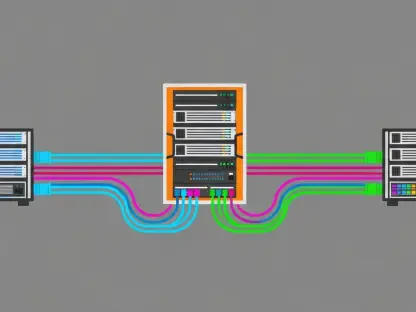In today’s data-driven world, businesses increasingly rely on real-time data processing to gain immediate insights and make informed decisions. Apache Spark Structured Streaming emerges as a powerful tool that simplifies the complexities of streaming data, enabling developers to write and execute streaming jobs as easily as batch jobs. However, managing the underlying infrastructure for these streaming jobs poses significant challenges. This is where Amazon EMR Serverless steps in, offering a scalable and cost-effective solution for running Spark Structured Streaming jobs without the necessity of managing clusters.
The Necessity of Streaming Solutions
The rapid generation of data from diverse sources such as social media, IoT devices, and e-commerce transactions has created an urgent need for efficient streaming solutions. Businesses require the ability to process this continuous stream of data in real-time to derive actionable insights and stay competitive. Traditional batch processing methods are becoming obsolete, as they cannot keep up with the sheer velocity and volume of data being generated every second.
Apache Spark Structured Streaming directly addresses these needs by providing high-level APIs that allow developers to write streaming jobs similar to batch jobs. This significantly simplifies the development process and enables real-time data processing capabilities. Despite these advantages, the challenge of managing the computing infrastructure for these streaming jobs lingers. In response, Amazon EMR Serverless has emerged as a game-changer by eliminating the need for setting up and managing clusters, allowing businesses to concentrate on their streaming applications rather than the complex underlying infrastructure.
Introduction to Amazon EMR Serverless
Amazon EMR Serverless introduces a revolutionary approach to real-time data processing, removing the hassles associated with setting up and maintaining clusters. This allows businesses to focus fully on their streaming applications while relying on EMR Serverless to handle all infrastructure requirements dynamically. By dynamically allocating computing resources based on workload demands, EMR Serverless ensures optimal performance and cost-efficiency.
Starting with Amazon EMR version 7.1, a job mode dedicated to streaming was introduced. This unique mode is designed to cater to the specific requirements of streaming workloads, providing a seamless and highly efficient solution for running Spark Structured Streaming jobs at scale. The introduction of this job mode has fundamentally altered how businesses execute real-time data processing by ensuring that resources are used efficiently and that costs are kept at a minimum.
Performance Enhancements with EMR Serverless
One of the major challenges of traditional Spark streaming applications stems from limited throughput due to shared shard-level read capacity. Amazon EMR Serverless tackles this issue head-on with the enhanced Kinesis Data Streams Connector, which provides dedicated read throughput for each consumer. By doing so, it significantly reduces latency and improves real-time processing efficiency, making it an ideal solution for high-throughput streaming applications that demand rapid data ingestion and processing.
Moreover, EMR Serverless offers fine-grained scaling by dynamically adjusting computing resources based on the specific needs of the workload. This dynamic scaling ensures that resources are neither over-provisioned nor under-provisioned, thus facilitating efficient management of unpredictable data volumes. The scalability of streaming jobs typically depends on the data source, and the optimal setup often involves a one-to-one ratio of Spark executor cores to Kinesis shards or Kafka partitions. This setup maximizes the efficiency and scalability of the streaming jobs, ensuring that the system can handle massive data volumes without performance degradation.
Cost Optimization Strategies
Effective cost management is a critical aspect of deploying streaming applications as it directly impacts the overall operational budget. Amazon EMR Serverless adopts a pricing model based on the utilization of vCPU, memory, and storage resources during active execution periods. The efficient scaling mechanisms embedded within EMR Serverless play a pivotal role in controlling costs by automatically adjusting resources in response to the current workload.
Several strategies can be employed to further optimize resource allocation and minimize costs, including modifying parameters like spark.dynamicAllocation.executorAllocationRatio and spark.dynamicAllocation.shuffleTracking.timeout. By fine-tuning these parameters, businesses can ensure that their resource usage is optimized, preventing wastage while maintaining high-performance levels. These strategies contribute significantly to cost-effective operations, making EMR Serverless an economically viable solution for businesses aiming to process real-time data efficiently without overshooting their budgets.
Built-in Resiliency Features
High availability and fault tolerance are vital for business-critical streaming applications, as any downtime can lead to significant data loss and operational disruptions. Amazon EMR Serverless leverages built-in resiliency features such as automatic failover capabilities that come into play in the event of Availability Zone failures. This ensures that job interruptions are minimized and continuous data processing is maintained, which is crucial for maintaining the integrity and reliability of business operations.
For achieving full resiliency, it is essential that input data sources also support Availability Zone failover. Configuring Amazon EMR Serverless to operate across multiple Availability Zones further enhances the system’s reliability. Additionally, the auto retry mechanism ensures that any failed jobs are automatically retried, thereby preventing data loss and enabling seamless restarts. Checkpointing mechanisms save computation states in Amazon S3, further bolstering the resiliency of streaming applications by allowing them to recover from failures without losing critical processing states.
Enhanced Observability and Monitoring
Effective observability is a cornerstone for troubleshooting, analyzing, and optimizing streaming workloads. Amazon EMR Serverless offers advanced log rotation and compression features to manage the large volumes of event logs generated by continuous data processing. By archiving and compressing rotated logs, the system ensures efficient use of storage while maintaining performance levels.
Application logs from Spark streaming applications’ drivers and executors can quickly consume disk space, leading to potential storage issues. EMR Serverless mitigates this by systematically rotating and compressing these logs, preventing disk space consumption from becoming a bottleneck. Enhanced monitoring capabilities are also offered, which include access to detailed engine metrics, Spark event timelines, stages, tasks, and executors through Amazon Managed Service for Prometheus. These robust monitoring capabilities provide valuable insights for performance analysis and optimization, enabling businesses to fine-tune their streaming applications for optimal efficiency and reliability.
Seamless Service Integrations
In today’s data-centric environment, businesses rely heavily on real-time data processing to gain instant insights and make data-driven decisions. Apache Spark Structured Streaming is a powerful tool that simplifies handling streaming data, allowing developers to write and run streaming jobs as easily as batch jobs. However, managing the infrastructure for these streaming tasks can be quite complex and challenging. This is where Amazon EMR Serverless becomes invaluable. It provides a scalable and cost-efficient solution for running Spark Structured Streaming jobs without the need to manage clusters. With Amazon EMR Serverless, businesses can focus on their core objectives without being bogged down by the intricacies of infrastructure management. This frees up resources and time, allowing for more innovation and efficiency. By leveraging such technology, companies can streamline their data processing capabilities and stay competitive in a fast-paced market.









